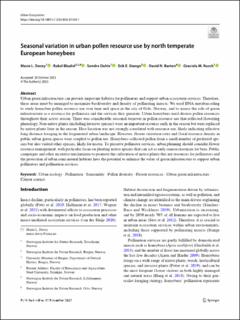| dc.contributor.author | Davey, Marie Louise | |
| dc.contributor.author | Blaalid, Rakel | |
| dc.contributor.author | Dahle, Sondre | |
| dc.contributor.author | Stange, Erik | |
| dc.contributor.author | Barton, David Nicholas | |
| dc.contributor.author | Rusch, Graciela Monica | |
| dc.date.accessioned | 2024-02-13T14:59:03Z | |
| dc.date.available | 2024-02-13T14:59:03Z | |
| dc.date.created | 2023-11-16T16:01:09Z | |
| dc.date.issued | 2023 | |
| dc.identifier.issn | 1083-8155 | |
| dc.identifier.uri | https://hdl.handle.net/11250/3117369 | |
| dc.description.abstract | Urban green infrastructure can provide important habitats for pollinators and support urban ecosystem services. Therefore, these areas must be managed to maximize biodiversity and density of pollinating insects. We used DNA metabarcoding to study honeybee pollen resource use over time and space in the city of Oslo, Norway, and to assess the role of green infrastructure as a resource for pollinators and the services they generate. Urban honeybees used diverse pollen resources throughout their active season. There was considerable seasonal turnover in pollen resource use that reflected flowering phenology. Non-native plants (including invasive species) were an important resource early in the season but were replaced by native plants later in the season. Hive location was not strongly correlated with resource use, likely indicating effective long-distance foraging in the fragmented urban landscape. However, flower visitation rates and floral resource density in public urban green spaces were coupled to pollen use. Honeybees collected pollen from a small number of preferred species but also visited other species, likely for nectar. To preserve pollinator services, urban planning should consider flower resource management, with particular focus on planting native species that can act as early season resources for bees. Public campaigns and other incentive mechanisms to promote the cultivation of native plants that are resources for pollinators and the protection of urban semi-natural habitats have the potential to enhance the value of green infrastructure to support urban pollinators and pollination services. Urban ecology · Pollination · Seasonality · Pollen diversity · Flower resources · Urban green infrastructure · Citizen science | en_US |
| dc.language.iso | eng | en_US |
| dc.publisher | Springer | en_US |
| dc.rights | Navngivelse 4.0 Internasjonal | * |
| dc.rights.uri | http://creativecommons.org/licenses/by/4.0/deed.no | * |
| dc.title | Seasonal variation in urban pollen resource use by north temperate European honeybees | en_US |
| dc.type | Journal article | en_US |
| dc.type | Peer reviewed | en_US |
| dc.description.version | publishedVersion | en_US |
| dc.rights.holder | Copyright 2023 The Author(s) | en_US |
| cristin.ispublished | true | |
| cristin.fulltext | original | |
| cristin.qualitycode | 1 | |
| dc.identifier.doi | 10.1007/s11252-023-01458-1 | |
| dc.identifier.cristin | 2197758 | |
| dc.source.journal | Urban Ecosystems | en_US |
| dc.relation.project | Egen institusjon: Norwegian institute for nature research (NINA) | en_US |
| dc.identifier.citation | Urban Ecosystems. 2023 | en_US |

